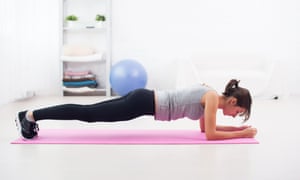The perfect ways to get fit – in 20 seconds, an hour or six months
Making time for exercise can be difficult because of work, family commitments or cost. Here’s how to squeeze it in, whatever your schedule

Twenty seconds
“Some people think if they can’t fit in a 60-minute gym routine, there’s no point,” says Steve Kamb, a fitness instructor and the founder of the training website NerdFitness. But, for many people, it takes a lot of courage just to get through the door to go for that first run. Giving yourself 20 seconds to be brave is a great stepping stone. Use it to Google a workout plan, or even just to walk into the gym and straight back out again, suggests Kamb. “It doesn’t matter if you finish the task just yet. Sometimes getting into the gym in the first place is the victory.”
Thirty seconds
Planking engages a number of muscles in the shoulders, back and stomach. Achieving a non-stop 30-second plank is harder than it looks, but planking helps to build a stronger core and improve posture and even flexibility. Muscle burns more calories than fat, so planking can help you to burn more calories even when you are not working out.

A couple of BuzzFeed writers who resolved to plank every day for 30 days, building up to a plank of two minutes, saw improvements in muscle definition by the end of their trial.
One minute
Sprinting for as little as a minute each day can reduce body fat, build muscle and increase the rate at which your body burns calories while resting. Marathon runners regularly incorporate short bursts of sprinting into training, as in the Swedish technique fartlek, because it drastically improves speed and cardiovascular fitness so that people can exercise longer. Sprints should be broken into 20-second bursts, so that you are working flat out. One study of obese men showed that they improved leg power and oxygen uptake in only two weeks.
Another found that one minute of sprint interval training, three times a week, had the same health benefits as 50 minutes of continuous moderate exercise, despite a five-fold lower time commitment (when taking into account the warm-up and cool-down). It is also one of the best abdominal workouts you can do – raising your leg at the 45-degree angle required for a proper sprint is equivalent to doing a crunch, and sprinters repeat this movement about 60 times in a 100-metre sprint.
Three minutes
If your goal is to one day do a pull up, starting with your grip strength could be an idea, because it is what determines whether you fall off the bar. “There’s nothing to stop you from picking up dumbells and going for a walk,” says Kamb. He suggests carrying them like suitcases at your side, an exercise known as “the farmer carry”. Each week your grip strength will get a little better.
Four minutes
A four-minute workout could help you to silence the voice in your head that says: “I don’t want to work out.” Tabata workouts are made up of 20-second intervals of intense exercise followed by 10 seconds of rest, repeated eight times, totalling four minutes. “Often when people miss one workout, they feel they’ve lost all their gains. Tabata keeps up momentum and will sustain your muscle growth even when you can’t make it to the gym,” says Kamb.
Five minutes
Get ready for tomorrow’s workout tonight. “Put your alarm clock against the other side of the room, a glass of water by your bed, sleep in your gym kit and put your shoes by your bed,” says Kamb. His reasoning? Everyone wants to be as lazy as possible when it comes to exercising – if you are already in your workout clothes when you wake up, you have eliminated a major hurdle.
Ten minutes
Take the stairs – it is great for you. Research shows that stair-climbing improves cardiovascular health and fitness, reduces “bad” cholesterol and can result in moderate weight loss. “You are raising your weight against gravity. Even going slowly, it’s as intense as jogging,” says Dr Frank Eves, a senior research fellow in sport, exercise and rehabilitation sciences at the University of Birmingham. “Climbing four flights of stairs will get your heart rate working at up to 80% of its maximum capacity. When you’re feeling breathless, surprisingly, it’s because your muscles just got a little bit fitter. Do that regularly and you’ll start to see bigger increases.”
But make sure you walk up – not down, he says: “We did a study where we put signs up saying ‘Take the stairs’ – but people just walked down. That defeats the point – climbing stairs is two to three times more strenuous.” Research has shown the health benefits for sedentary people of climbing 13 floors a day. Eves suggests spreading them throughout the day, at home or in coffee breaks at work.
Thirty minutes
Get off the bus or train a stop early and walk home. Researchers from Sheffield Hallam university looked into the benefits of walking for 30 minutes a day in three 10-minute bursts, compared with people fitting in the often recommended 10,000 steps a day. The 3,000-step walkers fared better. The researchers put this down to the intensity of the walks – so make sure your walk home is a brisk one.
Forty-five minutes
“Low-intensity steady state” cardio exercise (Liss) is essentially the opposite of high-intensity interval training (Hiit). It has cardiovascular benefits, as well as increasing and strengthening the legs. The advantange over Hiit is that you can do it for longer.
One hour

Health is as much about what you put in your mouth as it is how you move. Batch-cook your lunches for the coming week if you want to get ahead – when you are not hungry or rushed you will make healthier choices.
Nine weeks
This is enough time to complete the NHS’s Couch to 5K programme for absolute beginner runners. The programme builds up from walking to running 3.1 miles through three structured commitments a week and comes with a great podcast to keep you going.
Sixty-six days
It is often said it takes 21 days to form a habit. In fact, researchers at University College London who studied habit formation found that the average time for behaviour to become automatic was 66 days. If you want to improve your health, whether by drinking more water or eating a piece of fruit at lunch, try to stick with it for more than two months.
Sixteen weeks
If you can run 5km fairly easily, that is a good base to start training for a half-marathon. Training programmes tend to focus on building up to 13 miles over 12 to 16 weeks. Cancer Research UK has published various training timetables, starting with 20-minute runs. The developers of the Couch to 5K app have also created an app for first-time marathon runners called 26.2 Marathon Trainer.
Six months to one year
If applicable, quit smoking. Your lung capacity is a key part of exercising, as is your heart function and the transportation of oxygen through your blood – all of which are affected by smoking. It may take time – some research says quitters try an average of 30 times before stopping successfully – but it will be worth it. The risk of heart disease halves after a year without smoking and your lung function will improve, too.
This article contains affiliate links, which means we may earn a small commission if a reader clicks through and makes a purchase. All our journalism is independent and is in no way influenced by any advertiser or commercial initiative. By clicking on an affiliate link, you accept that third-party cookies will be set. More information.
It’s because of you…
… and the readers across all 50 states that supported us in 2019 that our journalism thrived in a challenging climate for publishers. Our readers provide us with the motivation and financial support to keep doing what we do.
Over the last three years, much of what we hold dear has been threatened – democracy, civility, truth. This US administration is establishing new norms of behaviour. Anger and cruelty disfigure public discourse and lying is commonplace. Truth is being chased away. The need for a robust, independent press has never been greater, and with your help we can continue to provide fact-based reporting that offers public scrutiny and oversight.
Our journalism is made possible thanks to the support we received from readers like you. Reader generosity helps protect our independence and it allows us to keep delivering quality reporting that’s open for all.
“America is at a tipping point, finely balanced between truth and lies, hope and hate, civility and nastiness. Many vital aspects of American public life are in play – the Supreme Court, abortion rights, climate policy, wealth inequality, Big Tech and much more. The stakes could hardly be higher. As that choice nears, the Guardian, as it has done for 200 years, and with your continued support, will continue to argue for the values we hold dear – facts, science, diversity, equality and fairness. Thank you.” – US editor, John Mulholland
We are asking our readers help to prepare for 2020. Please consider supporting us today with a year-end gift.